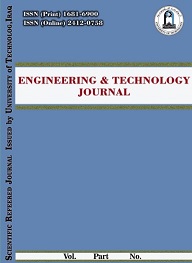Abstract
Alumina-doped Zinc Oxide (AZO) thin films on quarts glass substrates
have been deposited by pulsed laser deposition technique using a pulsed Nd-YAG
laser with the wavelength of (λ= 532 nm) and duration (7ns).
The structural and optical properties of these films were characterized as a
function of Al2O3 content (0-5w.t%)in the target at substrate temperatures (400°C)
and energy fluence (0.4 J/cm2). The X-ray diffraction patterns of the films showed
that the undoped and Al2O3 -doped ZnO films exhibit wurtzite crystal structure
and high crystalline quality. The optical properties were characterized by
transmittance, absorption spectroscopy measurements. For all films the average
transmission in the wavelength range (330-900) nm was over 90% and the
absorption edge shifted toward a shorter wavelength as Al2O3 concentration
increased. The optical energy gap of Al2O3 doped ZnO thin films, measured from
transmittance spectra could be controlled between (3.32eV and 3.59eV) by
adjusting alumina concentration. AFM results show that the samples with
increasing concentration of Al2O3, the surface roughness increases
have been deposited by pulsed laser deposition technique using a pulsed Nd-YAG
laser with the wavelength of (λ= 532 nm) and duration (7ns).
The structural and optical properties of these films were characterized as a
function of Al2O3 content (0-5w.t%)in the target at substrate temperatures (400°C)
and energy fluence (0.4 J/cm2). The X-ray diffraction patterns of the films showed
that the undoped and Al2O3 -doped ZnO films exhibit wurtzite crystal structure
and high crystalline quality. The optical properties were characterized by
transmittance, absorption spectroscopy measurements. For all films the average
transmission in the wavelength range (330-900) nm was over 90% and the
absorption edge shifted toward a shorter wavelength as Al2O3 concentration
increased. The optical energy gap of Al2O3 doped ZnO thin films, measured from
transmittance spectra could be controlled between (3.32eV and 3.59eV) by
adjusting alumina concentration. AFM results show that the samples with
increasing concentration of Al2O3, the surface roughness increases
